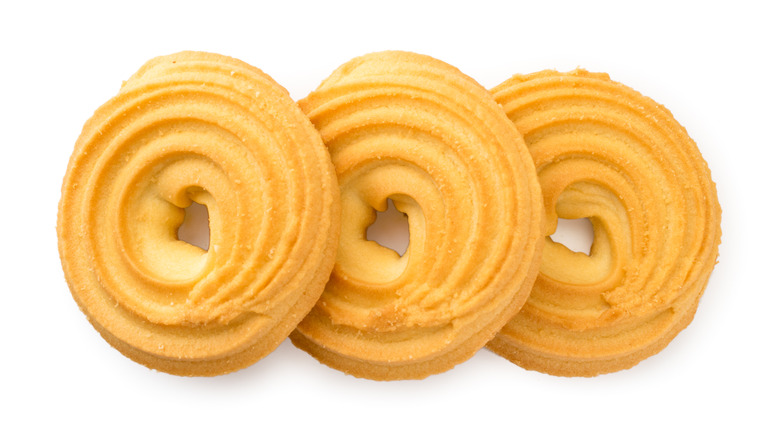The Ideal Dough Consistency For Successful Danish Butter Cookies
The iconic blue tin filled with Danish butter cookies is a household staple every holiday season, but that doesn't mean these cookies can't be enjoyed year-round. If you attempt to make your own Danish butter cookies at home, you'll find that the process is a fair deal easier than you might expect. Out of the array of butter cookie shapes available in the Royal Dansk blue cookie tin, the ridged, ring-shaped cookies are arguably the most famous ones.
Maybe you've thought about trying your hand at home-baked Danish butter cookies. What do you need to know before getting started? Well, Danish butter cookies are undoubtedly different from standard butter cookies and shortbread, with their signature shape, flavor, and crisp edge. The flavor part is simple enough to get right, but the shape and texture can be more difficult to pull off successfully. Of course, you won't be happy if your Danish butter cookies turn out dense, chewy, or shapeless. So if you want them to look and taste like those found in the blue tin, it all comes down to the texture of the dough.
Pipeable yet firm
Amanda's Cookin' states that this dough should be pipeable but thick, making it tough to squeeze through the piping tip; so its consistency should be quite firm, yet pliable like mashed potatoes. Most butter cookie recipes have a high-butter-content dough that is shaped into a log or brick to be chilled in the refrigerator, as shown in Preppy Kitchen's recipe. This step yields a firm, solid dough that is easy to cut into slices. But what separates Danish butter cookies from standard butter cookies is their signature ring shape.
As it would be impossible to cut out the ridged ring shape of the vanilla Danish butter cookie from a chilled brick of dough, the dough must be piped directly onto the baking sheet. To have a pipeable cookie dough, the consistency should be fluffy and more pliable than the average cookie dough. According to Amanda's Cookin', this butter cookie dough is made by creaming room-temperature butter and powdered sugar sufficiently and then working in an egg, and lastly, adding the unique flour mixture.
Creaming together butter and sugar gives this cookie dough its pliable texture, while also giving the cookie height through aeration, per Masterclass. Another reason why Danish butter cookies hold their shape so well is the addition of almond flour, which gives the cookie a slightly nutty aroma and a pleasing snap (via The Spruce Eats).

